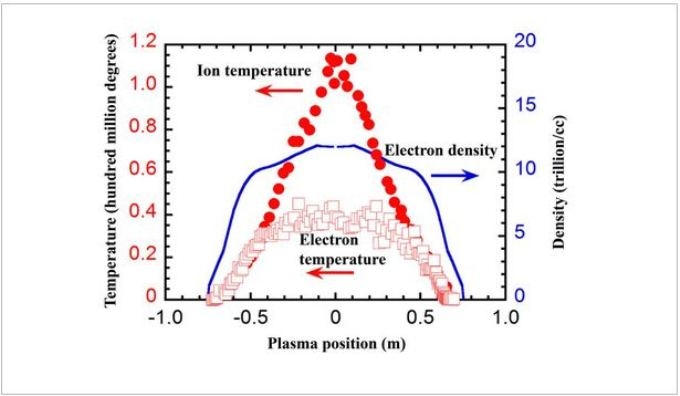Jul 17 2017
In order to achieve burning plasma, it is necessary to steadily maintain high-temperature and high-density plasma. In plasma research conducted to date on the LHD, utilizing the special characteristics of helical-type magnetic confinement, we have demonstrated excellent qualities in steady-state operation and high-density plasma. Thus, achieving high-temperature became an important issue.
 In an area where the ion temperature is higher than the electron temperature, a steep temperature gradient is formed due to the formation of the internal transport barrier (ITB). Credit: Dr. Kenichi Nagaoka
In an area where the ion temperature is higher than the electron temperature, a steep temperature gradient is formed due to the formation of the internal transport barrier (ITB). Credit: Dr. Kenichi Nagaoka
The fusion reaction, which indicates utilization of power generation, is the reaction of deuterium and tritium, of which the cross-section is at its highest in the range from one hundred million degrees to one thousand million degrees. When the temperature falls below one hundred million degrees, it suddenly becomes difficult for the reaction to occur, because when the temperature becomes one-tenth, the cross-section of the fusion reaction becomes 1/10,000. That is, in order to maintain fusion burning, the ion temperature must exceed one hundred million degrees. In the LHD, to date we have performed experiments that have aimed to achieve higher-temperature in hydrogen plasmas. However, we were unable to achieve temperatures that exceeded one hundred million degrees.
In the current experimental campaign, we engaged in raising plasma temperature as one of the main targets. In the LHD, as a method for heating plasma, we inject from outside a beam for plasma heating (NBI heating). As NBI heating, we use both methods for accelerating the positive ions and for accelerating the negative ions. Using the positive ion beam, when switching from the hydrogen beam to the deuterium beam it becomes possible to increase beam power due to making the beam energy higher. On the other hand, for the negative beam when the ion species changes from hydrogen to deuterium the beam current decreases resulting in beam power decrease. That is, by combining the positive ion deuterium beam and the negative ion hydrogen beam, the heating power is at its highest. Following this method, we performed high power beam plasma heating experiments than ever. As a result, we succeeded in generating plasma bearing an ion temperature of one hundred million degrees for the first time in a helical plasma. This high ion temperature plasma has a profile called internal transport barrier (ITB). When an ITB is formed, heat transport is suppressed and the core area of the plasma can reach a high temperature due to a steep temperature gradient having been formed. The characteristic of selectively expelling impurity ions that entered the plasma, which was discovered in hydrogen plasma experiments, also has been confirmed in deuterium ITB plasma in which the temperature exceeds one hundred million degrees. That is, we were also able to confirm that there are characteristics appropriate to fusion reactor plasmas. In the future, we will investigate in detail the transport characteristics of plasma whose temperature exceeds one hundred million degrees. By examining in detail the characteristics of hydrogen plasma and deuterium plasma, we anticipate research results that will link also to clarification of the ion mass dependency (isotope effect) regarding heat transport in the plasma, which has been a long-standing riddle in magnetic field confinement plasma experiments.